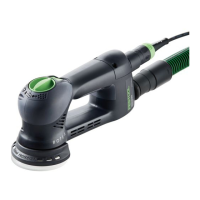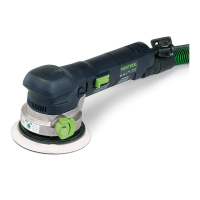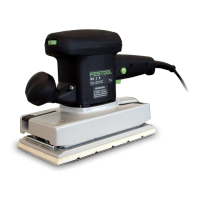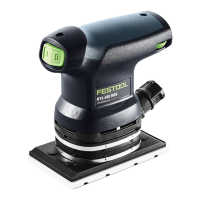Supplemental Owner’s Manual 5
conditions and the work to be performed. Use of the power
tool for operations different from those intended could result
in a hazardous situation.
► To reduce the risk of serious injury, never alter or misuse the
power tool.
Service
► Have your power tool serviced by a qualied repair person
using only identical replacement parts. This will ensure that
the safety of the power tool is maintained.
Specic Safety Rules for Sanders
► Know the material you are sanding and take precautions
accordingly. Some materials contain chemicals, elements,
or bers which may be toxic or harmful when abraded. Take
caution to prevent dust or vapor inhalation and skin contact.
► Always perform sanding in a well ventilated area and use
personal respiratory protection.
► Do not use in wet environments. Ingestion of water into the
motor may result in electrocution hazard.
► Do not use the sander if the sanding pad fails to retain the
sanding disk. Replace the sanding pad. A loose sanding disk
can come free and cause personal injury.
► Take care when disposing of ne sanding dust. Fine particle
dust may become explosive. Do not throw sanding dust on an
open ame.
► Never sand materials containing asbestos.
Respiratory Exposure Safety Warnings
Substantial or repeated inhalation of dust and other airborne
contaminants, in particular those with a smaller particle size,
may cause respiratory or other illnesses. Various dusts created
by power sanding, sawing, grinding, drilling and other construc-
tion activities contain chemicals or substances known (to the
State of California and others) to cause cancer, birth defects or
other reproductive harm. Some examples of these chemicals/
substances are: lead from lead-based paints; crystalline silica
from bricks, cement, and other masonry products; arsenic and
chromium from chemically-treated lumber; and some wood
dusts, especially from hardwoods, but also from some soft-
woods such as Western Red Cedar.
The risk from these exposures varies, depending on how often
you do this type of work. To reduce your exposure to these
chemicals: work in a well ventilated area and use a properly
functioning dust extraction system. When the inhalation of
dust cannot be substantially controlled, i.e., kept at or near the
ambient (background) level, the operator and any bystanders
should wear a respirator approved by NIOSH for the type of
dust encountered.
Sander Overview
Intended Use
The Rotex sanders are designed for dry sanding and polish-
ing of wood, plastic, metal, composite materials, paint/
varnish, ller, and similar materials.
The sander must not be used when wet or damp, or oper-
ated in a damp environment for electrical safety reasons.
Use this sander only for dry sanding. The tool should not
be altered or used for any other purpose, other than as
specied in these operating instructions. Using the tool in
contravention to this manual will void your warranty and
may lead to injury. The user shall be responsible and liable
for damages and accidents resulting from misuse or abuse
of this sander.
Technical Specications
RO 90 DX FEQ RO 125 FEQ RO 150 FEQ
Power Consumption 400 W 500 W 720 W
Orbital Speed 3000-7000 rpm 3000-6000 rpm 3300-6800 rpm
Rotational Speed (Rotex Mode) 260-520 spm 300-600 spm 320-660 spm
Orbital Stroke 3 mm 3.6 mm 5 mm
Sanding Pad Diameter 90 mm 125 mm 150 mm
Dust Extraction Port Size 27 mm 27 mm 27 mm
Weight 1.5 kg / 3.3 lbs 1.9 kg / 4.2 lbs 2.3 kg / 5.1 lbs
These specications are subject to change without notice.
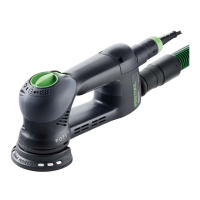
